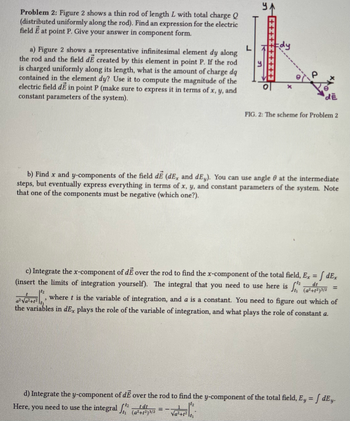Question
I need help can you label which one is A,B,C and D

Transcribed Image Text:Problem 2: Figure 2 shows a thin rod of length L with total charge Q
(distributed uniformly along the rod). Find an expression for the electric
field E at point P. Give your answer in component form.
a) Figure 2 shows a representative infinitesimal element dy along
the rod and the field dE created by this element in point P. If the rod
is charged uniformly along its length, what is the amount of charge dq
contained in the element dy? Use it to compute the magnitude of the
electric field dĒ in point P (make sure to express it in terms of x, y, and
constant parameters of the system).
L
ул
LC
▸
IV
Edy
P
de
FIG. 2: The scheme for Problem 2
b) Find x and y-components of the field dE (dEx and dEy). You can use angle at the intermediate
steps, but eventually express everything in terms of x, y, and constant parameters of the system. Note
that one of the components must be negative (which one?).
c) Integrate the x-component of de over the rod to find the x-component of the total field, Ex =
(insert the limits of integration yourself). The integral that you need to use here is ² dt
fdEx
(a²+1²)3/2
=
²√²+ where t is the variable of integration, and a is a constant. You need to figure out which of
the variables in dEx plays the role of the variable of integration, and what plays the role of constant a.
d) Integrate the y-component of de over the rod to find the y-component of the total field, Ey = | dEy.
Here, you need to use the integral (41) 3/2
Expert Solution
arrow_forward
Step 1
Given:
The charge of the rod is Q
The length of the rod placed along the y-axis is L
Step by stepSolved in 6 steps with 1 images

Knowledge Booster
Similar questions
- Next, imagine that a bullet impacts the block that you see and embeds itself. Let's say that you know the speed of the bullet just before it hits and also the mass of the bullet. Explain, with words and equations, how you would determine the angle theta. eed to know i L-h L Center of Pendulum catcharrow_forwardPlease look at the picture to answer the question correctly. Part 1) Which of the following represents a Newton's 2nd Law equation in the x direction? a. Fnet,x = Ffs - Fw cos θ b. Fnet,x = Ffs - Fw sin θ c. Fnet,x = -Fw sin θ - Ffs d. Fnet,x = Fn - Fw cos θ Part 2) Which of the following represents a Newton's 2nd Law equation in the y direction? a. Fnet,y = Fw - Fn b. Fnet,y = Fn - Fw sin θ c. Fnet,y = Fw sin θ - Ffs d. Fnet,y = Fn - Fw cos θ Please answer both partsarrow_forward45 Please use energy to solve Please label all free body diagrams and any formulas used Thanks!arrow_forward
- Q1 Please provide justified answer asap to get a upvotearrow_forwardCarbon Paper Ay Ax In Part 1 of the lab, a student collects the following data for a ball that is launched horizontally as shown above. Ax=74.3 cm Ay=103.5 cm In Part 3 of the lab, the student launches the ball at an angle of 38 degrees (as shown below). Ax Ay If Ay=15.5 cm and Ax = 24.9 cm, at what height does the hoop need to be for the ball to pass through it? Give your answer in centimeters to 3 significant figures.arrow_forward
arrow_back_ios
arrow_forward_ios